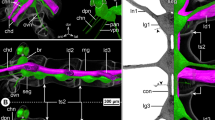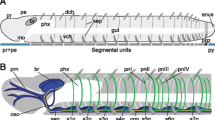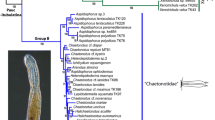Abstract
Within Spiralia, Gnathifera may represent the deepest branching lineage comprising the jaw worms Gnathostomulida and their sister group Micrognathozoa + Syndermata. Yet, very few nervous system studies have been conducted on this lineage of microscopic, jaw-bearing worms, limiting our understanding of the evolution of this organ system in Spiralia. The nervous system of representatives from all major groups of Gnathostomulida was here mapped using confocal laser scanning microscopy and immunohistochemistry. Their intra-epidermal, unsegmented nervous systems comprise an anterior brain and three to five ventral and two to four dorsal longitudinal nerves, connected by few transverse commissures. Neurites of the stomatogastric nervous system were found lining the pharynx and connecting to a prominent buccal ganglion. Supposedly, sensory ciliated cells in the pharynx and the gut were documented for the first time. Based on these morphological results, primary homologies of neural structures in Gnathostomulida and other Gnathifera were hypothesized and thereafter tested using parsimony. This first neurophylogeny of Gnathostomulida resulted in a topology congruent with molecular data, supporting the monophyly of Bursovaginoidea, Conophoralia, and Scleroperalia. From this topology, the evolution of the gnathostomulid nervous system was reconstructed. It suggests a specialization and diversification of cords and serotonin-like immunoreactive cell patterns from a plesiomorphic neuroarchitecture of three unsegmented nerve cords and a compact anterior brain and buccal ganglion. These plesiomorphic states resemble the nervous system of Micrognathozoa, and possibly the ancestral states of Spiralia.














Similar content being viewed by others
References
Ahlrichs, W. H. (1995). Seison annulatus und Seison nebaliae – Ultrastruktur und Phylogenie. Verhandlungen der Deutschen Zoologischen Gesellschaft, 88, 155.
Ax, P. (1956). Die Gnasthostomulida, eine rätselhafte Wurmgruppe aus dem Meeressand. Verlag der Akademie der Wissenschaften und der Literatur Mainz, mathematisch-naturwissenschaftliche Klasse, 8, 1–32.
Beckers, P., & van Döhren, J. (2016). Nemertea. In A. Schmidt-Rhaesa, S. Harzsch, & G. Purschke (Eds.), Structure and evolution of invertebrate nervous systems (pp. 148–165). New York: Oxford University Press.
Bekkouche, N., & Worsaae, K. (2016). Nervous system and ciliary structures of Micrognathozoa (Gnathifera): evolutionary insight from an early branch in Spiralia. Open Science, 3(10), 160289.
Bekkouche, N., Kristensen, R. M., Hejnol, A., Sørensen, M. V., & Worsaae, K. (2014). Detailed reconstruction of the musculature in Limnognathia maerski (Micrognathozoa) and comparison with other Gnathifera. Frontiers in Zoology, 11, 71.
Brenzinger, B., Haszprunar, G., & Schrödl, M. (2013). At the limits of a successful body plan—3D microanatomy, histology and evolution of Helminthope (Mollusca: Heterobranchia: Rhodopemorpha), the most worm-like gastropod. Frontiers in Zoology, 10, 37.
Clement, P., & Wurdak, E. (1991). Rotifera. In F. W. Harris & E. E. Ruppert (Eds.), Microscopic anatomy of invertebrates (Vol. Volume 4, pp. 219–297). New York: Wiley-Liss.
De Guerne, J. (1888). Excursions zoologiques dans les Isles de Fayal et de San Miguel (Açores). VII. Note monographique sur les rotiferes de la famille Asplanchnidae. In J. De Guerne (Ed.), Campagnes scientifiques du yacht monégasque l'Hirondelle (pp. 50–65). Paris: Gauthier-Villars et Fils, Imprimeurs-Libraires.
Di Domenico, M., Martínez, A., Lana, P., & Worsaae, K. (2014). Molecular and morphological phylogeny of Saccocirridae (Annelida) reveals two cosmopolitan clades with specific habitat preferences. Molecular Phylogenetics and Evolution, 75, 202–218.
Dunn, C. W., Hejnol, A., Matus, D. Q., Pang, K., Browne, W. E., Smith, S. A., et al. (2008). Broad phylogenomic sampling improves resolution of the animal tree of life. Nature, 452(7188), 745–749.
Ehrenberg, C. G. (1834). Organisation in der Richtung des kleinsten Raumes. Physiologische Abhandlungen: Dritter Beitrag.
Farris, R. A. (1977). Three new species of Gnathostomulida from the West Atlantic. Internationale Revue der gesamten Hydrobiologie und Hydrographie, 62(6), 765–796.
Fontaneto, D., & De Smet, W. (2015). 4. Rotifera. In A. Schmidt-Rhaesa (Ed.), Handbook of zoology, Gastrotricha and Gnathifera (pp. 217–300). Berlin, Munich and Boston: De Gruyter.
Golombek, A., Tobergte, S., & Struck, T. H. (2015). Elucidating the phylogenetic position of Gnathostomulida and first mitochondrial genomes of Gnathostomulida, Gastrotricha and Polycladida (Platyhelminthes). Molecular Phylogenetics and Evolution, 86, 49–63.
Hejnol, A., & Lowe, C. J. (2015). Embracing the comparative approach: how robust phylogenies and broader developmental sampling impacts the understanding of nervous system evolution. Philosophical Transactions of the Royal Society B, 370(1684), 20150045.
Herlyn, H., & Ehlers, U. (1997). Ultrastructure and function of the pharynx of Gnathostomula paradoxa (Gnathostomulida). Zoomorphology, 117(3), 135–145.
Higgins, R. P., & Thiel, H. (1988). Introduction to the study of meiofauna. Smithsonian Institution Press.
Hochberg, R. (2006). On the serotonergic nervous system of two planktonic rotifers, Conochilus coenobasis and C. dossuarius (Monogononta, Flosculariacea, Conochilidae). Zoologischer Anzeiger-A Journal of Comparative Zoology, 245(1), 53–62.
Hochberg, R. (2007). Topology of the nervous system of Notommata copeus (Rotifera: Monogononta) revealed with anti-FMRFamide, -SCPb, and -serotonin (5-HT) immunohistochemistry. Invertebrate Biology, 126(3), 247–256.
Hyman, L. H. (1951). IV. Class Rotifera. In L. H. Hyman (Ed.), The invertebrates: Acanthocephala, Aschelminthes, and Entoprocta. The pseudocoelomate Bilateria (Vol. Volume III, pp. 59–151). New York, Toronto, London: McGraw-Hill Book Company, Inc..
Jenner, R. A. (2004). Towards a phylogeny of the Metazoa: evaluating alternative phylogenetic positions of Platyhelminthes, Nemertea, and Gnathostomulida, with a critical reappraisal of cladistic characters. Contributions to Zoology, 73(1/2), 3–163.
Kerbl, A., Bekkouche, N., Sterrer, W., & Worsaae, K. (2015). Detailed reconstruction of the nervous and muscular system of Lobatocerebridae with an evaluation of its annelid affinity. BMC Evolutionary Biology, 15, 277.
Kirsteuer, E. (1969). On some species of Gnathostomulida from Bimini, Bahamas. Museum Novitates, 2356, 1–21.
Knauss, E. B. (1979). Indication of an anal pore in Gnathostomulida. Zoologica Scripta, 8(1–4), 181–186.
Kocot, K. M., Struck, T. H., Merkel, J., Waits, D. S., Todt, C., Brannock, P. M. et al. (2016). Phylogenomics of Lophotrochozoa with consideration of systematic error. Systematic Biology, syw079.
Kotikova, E. A. (1998). Catecholaminergic neurons in the brain of rotifers. In E. Wurdak, R. Wallace, & H. Segers (Eds.), Rotifera VIII: a comparative approach (pp. 135–140) .Springer Netherlands
Kotikova, E. A., Raikova, O. I., Reuter, M., & Gustafsson, M. K. (2005). Rotifer nervous system visualized by FMRFamide and 5-HT immunocytochemistry and confocal laser scanning microscopy. In A. Herzig, R. D. Gulati, C. D. Jersabek, & L. May (Eds.), Rotifera X: rotifer research: trends, new tools and recent advances (pp. 239–248). Netherlands: Springer.
Kristensen, R. M., & Funch, P. (2000). Micrognathozoa: a new class with complicated jaws like those of Rotifera and Gnathostomulida. Journal of Morphology, 246(1), 1–49.
Kristensen, R. M., & Nørrevang, A. (1977). On the fine structure of Rastrognathia macrostoma gen. et sp. n. placed in Rastrognathiidae fam. n. (Gnathostomulida). Zoologica Scripta, 6, 27–41.
Lammert, V. (1984). The fine structure of spiral ciliary receptors in Gnathostomulida. Zoomorphology, 104, 360–364.
Lammert, V. (1986). Vergleichende Ultrastruktur-Untersuchungen an Gnathostomuliden und die phylogenetische Bewertung ihrer Merkmale. PhD thesis, University of Göttingen.
Lammert, V. (1991). Gnathostomulida. In F. W. Harrison & E. E. Ruppert (Eds.), Microscopic anatomy of invertebrates (pp. 19–39). New York: Wiley-Liss.
Laumer, C. E., Bekkouche, N., Kerbl, A., Goetz, F., Neves, R. C., Sørensen, M. V., et al. (2015). Spiralian phylogeny informs the evolution of microscopic lineages. Current Biology, 25(15), 2000–2006.
Leasi, F., Pennati, R., & Ricci, C. (2009). First description of the serotonergic nervous system in a bdelloid rotifer: Macrotrachela quadricornifera Milne 1886 (Philodinidae). Zoologischer Anzeiger-A Journal of Comparative. Zoology, 248(1), 47–55.
Leasi, F., Fontaneto, D., & Melone, G. (2010). Phylogenetic constraints in the muscular system of rotifer males: investigation on the musculature of males versus females of Brachionus manjavacas and Epiphanes senta (Rotifera, Monogononta). Journal of Zoology, 282(2), 109–119.
Littlewood, D. T. J., Telford, M. J., Clough, K. A., & Rohde, K. (1998). Gnathostomulida—an enigmatic metazoan phylum from both morphological and molecular perspectives. Molecular Phylogenetics and Evolution, 9(1), 72–79.
Martínez, A., Di Domenico, M., Rouse, G. W., & Worsaae, K. (2015). Phylogeny and systematics of Protodrilidae (Annelida) inferred with total evidence analyses. Cladistics, 31(3), 250–276.
Milne, W. (1886). On the defectiveness of the eye-spot as a means of generic distinction in the Philodinaea, with a description of two other Rotifera. Proceedings of the Philosophical Society of Glasgow.
Moraczewski, J., Czubaj, A., & Bąkowska, J. (1977). Organization and ultrastructure of the nervous system in Catenulida (Turbellaria). Zoomorphologie, 87(1), 87–95.
Müller, M. C., & Sterrer, W. (2004). Musculature and nervous system of Gnathostomula peregrina (Gnathostomulida) shown by phalloidin labeling, immunohistochemistry, and cLSM, and their phylogenetic significance. Zoomorphology, 123(3), 169–177.
Nielsen, C., & Worsaae, K. (2010). Structure and occurrence of cyphonautes larvae (Bryozoa, Ectoprocta). Journal of Morphology, 271(9), 1094–1109.
Philippe, H., Brinkmann, H., Copley, R. R., Moroz, L. L., Nakano, H., Poustka, A. J., et al. (2011). Acoelomorph flatworms are deuterostomes related to Xenoturbella. Nature, 470(7333), 255–258.
Pleijel, F. (1995). On character coding for phylogeny reconstruction. Cladistics, 11(3), 309–315.
Remane, A. (1927). Neue Gastrotricha Macrodasyidea. Zoologische Jahrbuecher Systematik, 54, 203–242.
Reuter, M., Maule, A. G., Halton, D. W., Gustafsson, M. K. S., & Shaw, C. (1995). The organization of the nervous system in Plathelminthes. The neuropeptide Fimmunoreactive pattern in Catenulida, Macrostomida, Proseriata. Zoomorphology, 115, 83–97.
Riedl, R. J. (1970). On Labidognathia longicollis, nov. gen., nov. spec., from the West Atlantic Coast (Gnathostomulida). Internationale Revue der gesamten Hydrobiologie und Hydrographie, 55(2), 227–244.
Rieger, R. M., & Tyler, S. (1995). Sister-group relationship of Gnathostomulida and Rotifera-Acanthocephala. Invertebrate Biology, 114(2), 186–188.
Rieger, V., Perez, Y., Müller, C. H., Lipke, E., Sombke, A., Hansson, B. S., & Harzsch, S. (2010). Immunohistochemical analysis and 3D reconstruction of the cephalic nervous system in Chaetognatha: insights into the evolution of an early bilaterian brain? Invertebrate Biology, 129(1), 77–104.
Rothe, B. H., & Schmidt-Rhaesa, A. (2009). Architecture of the nervous system in two Dactylopodola species (Gastrotricha, Macrodasyida). Zoomorphology, 128(3), 227–246.
Rothe, B. H., Schmidt-Rhaesa, A., & Kieneke, A. (2011). The nervous system of Neodasys chaetonotoideus (Gastrotricha: Neodasys) revealed by combining confocal laserscanning and transmission electron microscopy: evolutionary comparison of neuroanatomy within the Gastrotricha and basal Protostomia. Zoomorphology, 130(1), 51–84.
Schmidt-Rhaesa, A. (2016). Gnathostomulida. In A. Schmidt-Rhaesa, S. Harzsch, & G. Purschke (Eds.), Structure and evolution of invertebrate nervous systems (pp. 118–121). New York: Oxford University Press.
Schmidt-Rhaesa, A., & Rothe, B. H. (2016). Gastrotricha. In A. Schmidt-Rhaesa, S. Harzsch, & G. Purschke (Eds.), Structure and evolution of invertebrate nervous systems (pp. 141–147). New York: Oxford University Press.
Sørensen, M. V. (2000). An SEM study of the jaws of Haplognathia rosea and Rastrognathia macrostoma (Gnathostomulida), with a preliminary comparison with the rotiferan trophi. Acta Zoologica, 81(1), 9–16.
Sørensen, M. V. (2002). Phylogeny and jaw evolution in Gnathostomulida, with a cladistic analysis of the genera. Zoologica Scripta, 31(5), 461–480.
Sørensen, M. V., & Giribet, G. (2006). A modern approach to rotiferan phylogeny: combining morphological and molecular data. Molecular Phylogenetics and Evolution, 40(2), 585–608.
Sørensen, M. V., Tyler, S., Hooge, M. D., & Funch, P. (2003a). Organization of pharyngeal hard parts and musculature in Gnathostomula armata (Gnathostomulida: Gnathostomulidae). Canadian Journal of Zoology, 81(9), 1463–1470.
Sørensen, M. V., Funch, P., Hooge, M., & Tyler, S. (2003b). Musculature of Notholca acuminata (Rotifera: Ploima: Brachionidae) revealed by confocal scanning laser microscopy. Invertebrate Biology, 122(3), 223–230.
Sørensen, M. V., Sterrer, W., & Giribet, G. (2006). Gnathostomulid phylogeny inferred from a combined approach of four molecular loci and morphology. Cladistics, 22(1), 32–58.
Sterrer, W. (1966). Gnathostoula paradoxa und Vertreter von Pterognathia (ein neues Gnathostomuliden-Genus) von der schwedischen Westküste. Arkiv för Zoologi, Serie 2, 18(16), 405–413.
Sterrer, W. (1969). Beiträge zur Kenntnis der Gnathostomulida I. Anatomie und Morphologie des Genus Pterognathia Sterrer. Arkiv för Zoologi, Serie 2, 22(1), 1–125.
Sterrer, W. (1970). On some species of Austrognatharia, Pterognathia and Haplognathia nov. gen. from the North Carolina coast (Gnathostomulida). Internationale Revue der gesamten Hydrobiologie und Hydrographie, 55(3), 371–385.
Sterrer, W. (1972). Systematics and evolution within the Gnathostomulida. Systematic Biology, 21(2), 151–173.
Sterrer, W. (1998). Gnathostomulida from the (sub)tropical northwestern Atlantic. Studies on the natural history of the Caribbean region, 74(1), 1–178.
Sterrer, W., & Sørensen, M. (2015). 2. Gnathostomulida. In A. Schmidt-Rhaesa (Ed.), Handbook of zoology, Gastrotricha and Gnathifera (pp. 135–196). Berlin, Munich and Boston: De Gruyter.
Struck, T. H., Wey-Fabrizius, A. R., Golombek, A., Hering, L., Weigert, A., Bleidorn, C., et al. (2014). Platyzoan paraphyly based on phylogenomic data supports a noncoelomate ancestry of spiralia. Molecular Biology and Evolution, 31(7), 1833–1849.
Tyler, S., & Hooge, M. D. (2001). Musculature of Gnathostomula armata Riedl 1971 and its ecological significance. Marine Ecology, 22(1–2), 71–83.
Ware, R. W., & Lopresti, V. (1975). Three-dimensional reconstruction from serial sections. International Review of Cytology, 40, 325–440.
Wilts, E. F., Ahlrichs, W. H., & Arbizu, P. M. (2009). The somatic musculature of Bryceella stylata (Milne, 1886)(Rotifera: Proalidae) as revealed by confocal laser scanning microscopy with additional new data on its trophi and overall morphology. Zoologischer Anzeiger-A Journal of Comparative Zoology, 248(3), 161–175.
Wilts, E. F., Wulfken, D., Ahlrichs, W. H., & Martínez Arbizu, P. (2012). The musculature of Squatinella rostrum (Milne, 1886) (Rotifera: Lepadellidae) as revealed by confocal laser scanning microscopy with additional new data on its trophi and overall morphology. Acta Zoologica, 93(1), 14–27.
Worsaae, K. (2005). Phylogeny of Nerillidae (Polychaeta, Annelida) as inferred from combined 18S rDNA and morphological data. Cladistics, 21(2), 143–162.
Worsaae, K., & Kristensen, R. M. (2003). A new species of Paranerilla (Polychaeta: Nerillidae) from northeast Greenland waters, arctic ocean. Cahiers de Biologie Marine, 44(1), 23–39.
Worsaae, K., & Kristensen, R. M. (2005). Evolution of interstitial Polychaeta (Annelida). In T. Bartolomaeus & G. Purschke (Eds.), Morphology, molecules, evolution and phylogeny in Polychaeta and related taxa (pp. 319–340). Netherlands: Springer.
Worsaae, K., & Müller, M. (2004). Nephridial and gonoduct distribution patterns in Nerillidae (Annelida: Polychaeta) examined by tubulin staining and cLSM. Journal of Morphology, 261(3), 259–269.
Worsaae, K., & Rouse, G. W. (2008). Is Diurodrilus an annelid? Journal of Morphology, 269(12), 1426–1455.
Worsaae, K., & Rouse, G. W. (2010). The simplicity of males: dwarf males of four species of Osedax (Siboglinidae; Annelida) investigated by confocal laser scanning microscopy. Journal of Morphology, 271(2), 127–142.
Worsaae, K., Sterrer, W., & Iliffe, T. M. (2004). Longipalpa saltatrix, a new genus and species of the meiofaunal family Nerillidae (Annelida: Polychaeta) from an anchihaline cave in Bermuda. Proceedings of the Biological Society of Washington, 117(3), 346–362.
Worsaae, K., Rimskaya-Korsakova, N. N., & Rouse, G. W. (2016). Neural reconstruction of bone-eating Osedax spp.(Annelida) and evolution of the siboglinid nervous system. BMC evolutionary biology, 16, 83.
Acknowledgements
We are very grateful to Wolfgang Sterrer, who helped with taxonomical identification of examined Gnathostomulida. We are also indebted to M.V. Sørensen, R. M. Kristensen, and A. Schmidt-Rhaesa, who shared information on good sampling sites for Gnathostomulida; R. M. Kristensen additionally aided with helpful comments on sensory structures and discussions of his unpublished material. We wish to thank as well all our colleagues, who helped with sampling and collecting of the material (especially A. Kerbl, B. Gonzalez and A. Martínez). This study was supported by the Villum Foundation (grant no. 102544).
Author information
Authors and Affiliations
Corresponding author
Ethics declarations
Conflict of interest
The authors declare that they have no conflict of interest.
Rights and permissions
About this article
Cite this article
Gąsiorowski, L., Bekkouche, N. & Worsaae, K. Morphology and evolution of the nervous system in Gnathostomulida (Gnathifera, Spiralia). Org Divers Evol 17, 447–475 (2017). https://doi.org/10.1007/s13127-017-0324-8
Received:
Accepted:
Published:
Issue Date:
DOI: https://doi.org/10.1007/s13127-017-0324-8




